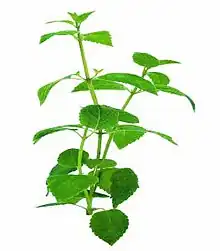| Minthostachys mollis | |
|---|---|
 | |
| Scientific classification | |
| Kingdom: | Plantae |
| Clade: | Tracheophytes |
| Clade: | Angiosperms |
| Clade: | Eudicots |
| Clade: | Asterids |
| Order: | Lamiales |
| Family: | Lamiaceae |
| Genus: | Minthostachys |
| Species: | M. mollis |
| Binomial name | |
| Minthostachys mollis | |
Minthostachys mollis is a medicinal plant restricted to the South American Andes from Peru Venezuela to Bolivia. It is the most variable and widely distributed species of the genus Minthostachys. It is known by the common names muña, tipo, tipollo, or poleo.[1]
Medicinal uses
In the indigenous medicine traditions of the Andes, the plant is made into tea and used medicinally as a carminative and aphrodisiac.
Etymology
Its common name "muña" comes from Quechua.
Chemical characteristics
The principal components of essential oil are as follows:
- pulegone
- menthone
- menthol
- (−)-β-pinene
- (−)-α-pinene
- limonene
- isomenthone
- piperic acid
- eucalyptol
- carvone
In the flowering tops 19 compounds were identified in the essential oil, predominantly 29% neomenthol, 24% menthone, 20% menthol, and 8% piperitone.[1]
References
- 1 2 Alkire, Ben (1994). "Tipo, Minthostachys mollis (Lamiaceae): an Ecuadorian mint". Economic Botany. 48 (1): 60–64. doi:10.1007/BF02901380. S2CID 5181013.
External links
- "Minthostachys mollis". Germplasm Resources Information Network. Agricultural Research Service, United States Department of Agriculture.
This article is issued from Wikipedia. The text is licensed under Creative Commons - Attribution - Sharealike. Additional terms may apply for the media files.